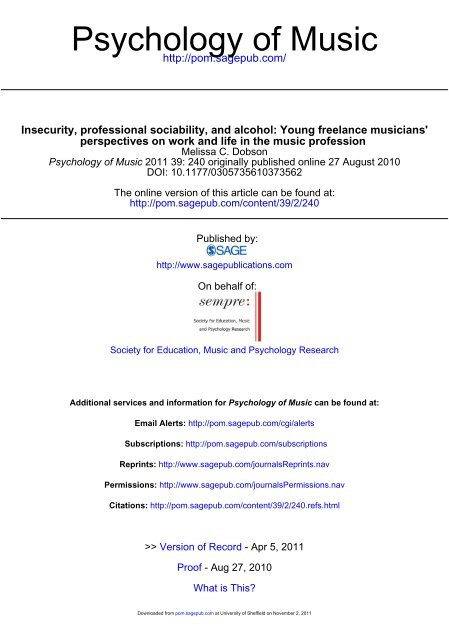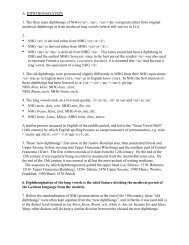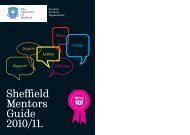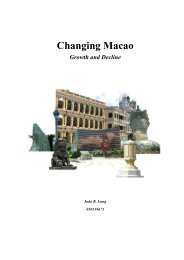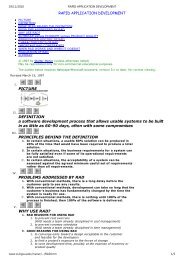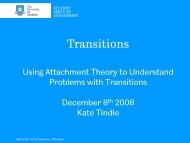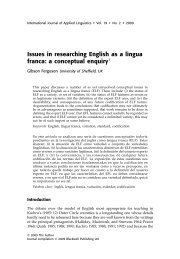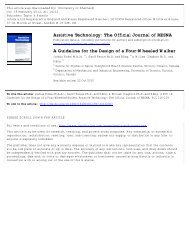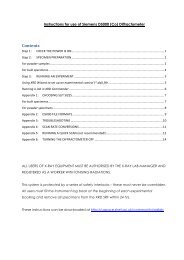Dobson, 2010.pdf - University of Sheffield
Dobson, 2010.pdf - University of Sheffield
Dobson, 2010.pdf - University of Sheffield
Create successful ePaper yourself
Turn your PDF publications into a flip-book with our unique Google optimized e-Paper software.
Psychology <strong>of</strong> Music<br />
http://pom.sagepub.com/<br />
Insecurity, pr<strong>of</strong>essional sociability, and alcohol: Young freelance musicians'<br />
perspectives on work and life in the music pr<strong>of</strong>ession<br />
Melissa C. <strong>Dobson</strong><br />
Psychology <strong>of</strong> Music 2011 39: 240 originally published online 27 August 2010<br />
DOI: 10.1177/0305735610373562<br />
The online version <strong>of</strong> this article can be found at:<br />
http://pom.sagepub.com/content/39/2/240<br />
Published by:<br />
http://www.sagepublications.com<br />
On behalf <strong>of</strong>:<br />
Society for Education, Music and Psychology Research<br />
Additional services and information for Psychology <strong>of</strong> Music can be found at:<br />
Email Alerts: http://pom.sagepub.com/cgi/alerts<br />
Subscriptions: http://pom.sagepub.com/subscriptions<br />
Reprints: http://www.sagepub.com/journalsReprints.nav<br />
Permissions: http://www.sagepub.com/journalsPermissions.nav<br />
Citations: http://pom.sagepub.com/content/39/2/240.refs.html<br />
>> Version <strong>of</strong> Record - Apr 5, 2011<br />
Pro<strong>of</strong> - Aug 27, 2010<br />
What is This?<br />
Downloaded from<br />
pom.sagepub.com at <strong>University</strong> <strong>of</strong> <strong>Sheffield</strong> on November 2, 2011
Article<br />
Insecurity, pr<strong>of</strong>essional sociability,<br />
and alcohol: Young freelance<br />
musicians’ perspectives on work<br />
and life in the music pr<strong>of</strong>ession<br />
Melissa C. <strong>Dobson</strong><br />
<strong>University</strong> <strong>of</strong> <strong>Sheffield</strong>, UK<br />
Psychology <strong>of</strong> Music<br />
39(2) 240–260<br />
© The Author(s) 2010<br />
Reprints and permission: sagepub.<br />
co.uk/journalsPermission.nav<br />
DOI: 10.1177/0305735610373562<br />
pom.sagepub.com<br />
Abstract<br />
Research addressing a link between musical creativity and mental disorder has predominantly<br />
considered composers rather than performers, and has been dominated by the questionable use <strong>of</strong><br />
retrospective biographical research methods. This article calls for research to explore more widely<br />
the stressors and challenges that living musicians face in their work and lives. Semi-structured<br />
interviews were undertaken with 18 young musicians (nine freelance classical string players and<br />
nine jazz musicians). The participants expressed concern over their lack <strong>of</strong> job and financial security,<br />
and stressed the importance <strong>of</strong> reputations in the networks <strong>of</strong> musicians in which they operate.<br />
Socializing pr<strong>of</strong>essionally was identified as a key means <strong>of</strong> advancing work prospects, in which alcohol<br />
consumption <strong>of</strong>ten played a strong role. Drinking patterns were also associated with the demands <strong>of</strong><br />
performance, with alcohol consumption arising either as a consequence <strong>of</strong> pressure or boredom. These<br />
results are discussed in light <strong>of</strong> the limited existing research investigating musicians’ uses <strong>of</strong> alcohol.<br />
Keywords<br />
alcohol, freelance musicians, jazz, job insecurity, musicians’ lifestyles, reputations, social competence, string<br />
players<br />
This study emerged from an interest in the possibility <strong>of</strong> a relationship between creativity and<br />
psychopathology, particularly in reference to music practitioners. This purported relationship,<br />
and the romanticized notion <strong>of</strong> the ‘mad genius’ creator with which it is associated, have<br />
attracted attention in both academic discourse and popular media (Schlesinger, 2002). Much<br />
research in this field has employed retrospective biographical research methods, whereby<br />
researchers examine the biographical sources <strong>of</strong> creative individuals for indications <strong>of</strong> psychiatric<br />
disorder (e.g., Jamison, 1993; Ludwig, 1995; Post, 1994). 1 Among studies using these<br />
methods on music practitioners, classical performers have largely been neglected, with a focus<br />
instead on jazz musicians (Tolson & Cuyjet, 2007; Wills, 2003) and classical composers (Frosch,<br />
Corresponding author:<br />
Melissa C. <strong>Dobson</strong>, <strong>University</strong> <strong>of</strong> <strong>Sheffield</strong>, Department <strong>of</strong> Music, Jessop Building, 34 Leavygreave Road, <strong>Sheffield</strong>, S3 7RD.<br />
[email: melissa.dobson@hotmail.co.uk]<br />
Downloaded from<br />
pom.sagepub.com at <strong>University</strong> <strong>of</strong> <strong>Sheffield</strong> on November 2, 2011
<strong>Dobson</strong> 241<br />
1987; Trethowan, 1977): groups <strong>of</strong> musicians perceived to exhibit ostensibly higher levels <strong>of</strong><br />
creativity in their work than classical performers (Cottrell, 2004; cf. Seddon & Biasutti, 2009).<br />
Yet research on living classical musicians finds that their work can exert detrimental effects on<br />
their physical and psychological health (Brodsky, 2006; Parasuraman & Purohit, 2000), and<br />
opponents <strong>of</strong> the use <strong>of</strong> retrospective biographical methods have called for a broader investigation<br />
<strong>of</strong> the factors which affect musicians’ well-being (e.g. Schlesinger, 2003). This research<br />
attempts to deconstruct the ‘mad genius’ myth in relation to performing musicians, demonstrating<br />
the increased relevance <strong>of</strong> findings emerging from a study <strong>of</strong> living individuals, and<br />
presenting a realistic picture <strong>of</strong> the pressures and challenges that freelance musicians face.<br />
Two large-scale studies examining the biographies <strong>of</strong> ‘eminent’ individuals for evidence <strong>of</strong><br />
mental disorder indicate that, in relation to composers, a link between musical creativity and<br />
psychopathology is less concrete than <strong>of</strong>ten portrayed. Ludwig (1995) found that composers<br />
possessed the lowest lifetime prevalence rates for mental disorder among the arts pr<strong>of</strong>essions,<br />
while Post’s (1994) survey <strong>of</strong> biographies indicated that composers exhibited the second lowest<br />
prevalence rates for incidence <strong>of</strong> psychopathology among a sample <strong>of</strong> scientists, politicians,<br />
artists, thinkers and writers. Frosch (1987, p. 322) stated that there is ‘no compelling evidence’<br />
for a ‘pathology <strong>of</strong> musical creativity’ in composers, arguing that ‘our image <strong>of</strong> the mad creator<br />
is drawn from those few vivid examples, such as Schumann, and draws its strength from nineteenth-century<br />
romantic notions <strong>of</strong> the hero’ (p. 321). Indeed, the allure <strong>of</strong> viewing artistry as<br />
a tortured process is exemplified by research which seeks to find ‘evidence’ <strong>of</strong> psychopathology<br />
in composers’ musical works (e.g., Caldwell, 1972) or which uses biographies to attempt to<br />
identify psychological problems experienced by specific composers. Taking Mozart as an example,<br />
studies have variously asserted that he suffered from a wide range <strong>of</strong> medical conditions,<br />
including cyclothymia (Davies, 1987) and Tourette’s syndrome (Simkin, 1992), although more<br />
recent literature has disputed these claims (Ashoori & Jankovic, 2007). More widely, researchers<br />
interested in a creativity–psychopathology link have questioned the use <strong>of</strong> biographies as<br />
reliable sources (Poole, 2003; Schlesinger, 2004b) and raised objections to the use <strong>of</strong><br />
‘psychological autopsies’ as research methods (Schlesinger, 2004a, p. 184).<br />
These recent methodological critiques were prompted by research by Wills (2003), who formed<br />
psychiatric diagnoses from the biographies <strong>of</strong> jazz musicians eminent between 1945 and 1960.<br />
He found that 28.5% <strong>of</strong> the sample suffered from affective disorders, 27.5% from alcohol-related<br />
disorder, and 52.5% from heroin-related disorder (pp. 256–257). While living performers’ uses <strong>of</strong><br />
substances have been explored in relation to both amateur (Groce, 1991; Grønnerød, 2002) and<br />
pr<strong>of</strong>essional rock musicians (Raeburn 1987a, 1987b), there is little contemporary research into<br />
the role <strong>of</strong> work-related alcohol consumption in pr<strong>of</strong>essional jazz and classical musicians. 2 Of<br />
Raeburn, Hipple, Delaney, and Chesky’s (2003) two convenience samples used to survey popular<br />
(including jazz) musicians’ health, 10% and 16% <strong>of</strong> the respective groups indicated that substance<br />
use had affected their performances over the past year (p. 116). The International<br />
Conference <strong>of</strong> Symphony and Opera Musicians (ICSOM) study <strong>of</strong> symphony orchestras found<br />
that 21% <strong>of</strong> musicians were worried about the effects <strong>of</strong> their alcohol consumption (Fishbein,<br />
Middlestadt, Ottati, Straus, & Ellis, 1988), but as with Raeburn and colleagues’ (2003) study, its<br />
findings cannot necessarily be generalized beyond prevailing attitudes held in the United States<br />
(US) towards drinking. Given the differences in drinking cultures between countries (Bloomfield,<br />
Greenfield, Kraus, & Augustin, 2002; Kuntsche, Rehm, & Gmel, 2004), there is a clear need for<br />
research in this area to be undertaken in countries other than the US – as demonstrated by the<br />
inexorable reliance on anecdote that was evident in a recent United Kingdom (UK) media debate<br />
on orchestral musicians’ drinking habits (see Higgins, 2009; Nwanoku, 2009).<br />
Downloaded from<br />
pom.sagepub.com at <strong>University</strong> <strong>of</strong> <strong>Sheffield</strong> on November 2, 2011
242 Psychology <strong>of</strong> Music 39(2)<br />
Work-related alcohol consumption among musicians has been attributed to its role in maintaining<br />
group membership (Grønnerød, 2002; Raeburn, 1999; Wills & Cooper, 1984). Alcohol research<br />
has highlighted occupational cultures amongst journalists and naval <strong>of</strong>ficers (Cosper & Hughes,<br />
1982) and manufacturing plant workers (Ames & Grube, 1999; Ames & Janes, 1987) where workrelated<br />
drinking ‘becomes normative behaviour that is interactive with the overall organizational<br />
culture <strong>of</strong> the workplace’ (Ames & Janes, 1992), playing an important role in the formation and<br />
maintenance <strong>of</strong> social networks. Data from Martin, Roman, and Blum’s (1996, p. 593) crossoccupational<br />
sample indicated that ‘participation in a work-based drinking network ... emerged as a<br />
powerful predictor <strong>of</strong> problem drinking status’, with employees who regularly drank with colleagues<br />
more likely to view drinking as a means <strong>of</strong> coping with job dissatisfaction or job stress.<br />
Wills and Cooper (1988) focused on the sources <strong>of</strong> occupational stress faced by popular<br />
musicians, considering the effects <strong>of</strong> musicians’ lifestyles on well-being and mental health.<br />
While financial security and sporadic working patterns were significant sources <strong>of</strong> stress, the<br />
greatest sources <strong>of</strong> pressure originated from maintaining standards <strong>of</strong> playing to a level that<br />
met the musicians’ own ideals. However, this study’s tendency to finely categorize the types <strong>of</strong><br />
musician working within the popular field (using player categories such as ‘jazz/gig’, ‘commercial/gig’<br />
and ‘commercial/session’) does not adequately reflect the current need for both popular<br />
and classical freelance musicians to be as adaptable as possible to ensure financial survival<br />
in a competitive work environment (Bennett, 2007; Cottrell, 2007). This is particularly the<br />
case for jazz musicians, who are <strong>of</strong>ten less well remunerated than popular musicians performing<br />
in other styles (Cottrell, 2004), with the ‘jazz life’ characterized as one <strong>of</strong> ‘relative poverty<br />
and hard work’ (MacDonald & Wilson, 2005, p. 405).<br />
From a predominantly classical perspective, research has begun to address the health problems<br />
<strong>of</strong> conservatoire students (e.g., Ginsborg, Kreutz, Thomas, & Williamon, 2009; Williamon<br />
& Thompson, 2006), and their experiences <strong>of</strong> the <strong>of</strong>ten difficult transition between amateur<br />
and pr<strong>of</strong>essional states (Burland & Davidson, 2002). In research concerned with fully pr<strong>of</strong>essional<br />
musicians, Marchant-Haycox & Wilson (1992) attributed classical musicians’ high levels<br />
<strong>of</strong> stress to a competitive work environment, constant criticism from external sources, and<br />
unconventional working patterns. The ICSOM survey <strong>of</strong> 2,212 orchestral musicians’ health,<br />
which encompassed both physical and psychological problems, found that medical problems<br />
were most prevalent among string players (Fishbein et al., 1988). While an existing body <strong>of</strong><br />
research focuses on the internal psychological workings <strong>of</strong> string quartets (Davidson & Good,<br />
2002; Murnighan & Conlon, 1991; Young & Colman, 1979), research has neglected to consider<br />
freelance string players, whose livelihood might involve negotiating the demands <strong>of</strong> both<br />
orchestral and chamber music performance within a larger portfolio <strong>of</strong> work.<br />
The present study gathers data from freelance jazz musicians and string players to explore<br />
the challenges and stressors involved in young freelance musicians’ work and associated lifestyles.<br />
It aims to use the differences in the work <strong>of</strong> these two groups <strong>of</strong> musicians to gain a rich<br />
picture <strong>of</strong> freelance life, and simultaneously aims to gain perspectives on performers’ experiences<br />
<strong>of</strong> their tertiary education.<br />
Method<br />
Participants<br />
Semi-structured interviews were conducted with 18 participants: nine jazz musicians (coded<br />
J1–J9) and nine freelance string players (S1–S9). Their ages ranged from 21 to 34. Overall, the<br />
Downloaded from<br />
pom.sagepub.com at <strong>University</strong> <strong>of</strong> <strong>Sheffield</strong> on November 2, 2011
<strong>Dobson</strong> 243<br />
Table 1. Participant pr<strong>of</strong>iles<br />
Code Age Gender Status Instrument(s)<br />
Jazz<br />
J1 21 Male <strong>University</strong> UG 1 (3rd year) Trumpet<br />
J2 22 Male <strong>University</strong> PG 2 (1st year) Piano<br />
J3 21 Male Conservatoire UG (4th year) Drums<br />
J4 28 Female Pr<strong>of</strong>essional Singer<br />
J5 25 Male Pr<strong>of</strong>essional Bass guitar<br />
J6 31 Male Pr<strong>of</strong>essional Saxophone<br />
J7 26 Male Pr<strong>of</strong>essional Piano, bass<br />
J8 25 Male Pr<strong>of</strong>essional Piano<br />
J9 34 Female Pr<strong>of</strong>essional Piano<br />
Strings<br />
S1 22 Female <strong>University</strong> UG (3rd year) Violin<br />
S2 22 Male <strong>University</strong> PG (1st year) Cello<br />
S3 21 Male Conservatoire UG (4th year) Violin<br />
S4 22 Female Conservatoire PG (1st year) Cello<br />
S5 23 Female Conservatoire PG (1st year) Viola<br />
S6 22 Male Conservatoire PG (2nd year) Violin<br />
S7 26 Female Pr<strong>of</strong>essional Viola<br />
S8 24 Male Pr<strong>of</strong>essional Violin<br />
S9 28 Female Pr<strong>of</strong>essional Cello<br />
Note: 1 UG = Undergraduate; 2 PG = Postgraduate.<br />
sample consisted <strong>of</strong> 11 men and seven women. This imbalance stemmed from the jazz group:<br />
only two <strong>of</strong> the nine jazz participants were women, while the string group comprised five<br />
women and four men. A more balanced sample was initially sought, but difficulties were<br />
encountered identifying female jazz musicians to interview, and time limitations on a research<br />
trip to London meant that a better matched sample could not be pursued. The participants’<br />
educational and pr<strong>of</strong>essional statuses spanned a continuum, beginning with university music<br />
students already undertaking paid freelance work and hoping to embark on performance<br />
careers, followed by students at London conservatoires, and ending with pr<strong>of</strong>essional musicians<br />
(see Table 1). The ambiguity between these states must be noted, however, as in some<br />
cases the boundaries between student and pr<strong>of</strong>essional were distinctly blurred, with some ‘student’<br />
participants working pr<strong>of</strong>essionally as much as any other ‘pr<strong>of</strong>essional’ might expect to. 3<br />
As a string player, the author accessed potential interviewees through peer networks. While<br />
some participants were known to the author as friends, others were previously only ‘known <strong>of</strong>’,<br />
and some were completely unknown: in these cases contact was established via telephone numbers<br />
provided by mutual acquaintances. It is likely that the varying degrees <strong>of</strong> acquaintance<br />
between the author and participants affected the course <strong>of</strong> the interviews, although ascertaining<br />
(or generalizing) the nature <strong>of</strong> these effects is difficult. The participants who viewed the<br />
author as a friend may have been more open to discussing sensitive topics. Alternatively, because<br />
their interview was part <strong>of</strong> an ongoing association with the author, rather than a one-<strong>of</strong>f<br />
encounter, the elements <strong>of</strong> formality inherent in a semi-structured interview may have been<br />
more noticeable, leading them to feel less, rather than more, at ease within the interview context.<br />
These participants may have been more likely to actively censor their responses so that they<br />
did not include details which they would not wish the author to know. However, as all participants<br />
were accessed through peer networks, it is plausible that this may be the case, in varying<br />
Downloaded from<br />
pom.sagepub.com at <strong>University</strong> <strong>of</strong> <strong>Sheffield</strong> on November 2, 2011
244 Psychology <strong>of</strong> Music 39(2)<br />
degrees, throughout the sample. Conversely, the author’s status as ‘musician’ in addition to<br />
‘researcher’ may have engendered a feeling <strong>of</strong> shared understanding and trust. 4<br />
The participants were approached initially by phone: implicit consent was assumed by their<br />
agreement to take part after hearing an outline <strong>of</strong> the interview schedule. Before each interview<br />
started participants were assured <strong>of</strong> the confidentiality <strong>of</strong> their answers and that data<br />
from their interview transcripts would be treated anonymously. They were asked for their permission<br />
to record the interview and were informed <strong>of</strong> their right to withdraw from the study<br />
at any time.<br />
Interview schedule<br />
This article originates from a broader study, the interview schedule for which is provided<br />
(see Appendix). <strong>Dobson</strong> (2010) presents other findings from the research. The interview<br />
schedule began with a warm-up period which sought details <strong>of</strong> the participants’ work or<br />
study, before asking them to consider how working as a musician affected their lifestyle.<br />
They were asked to identify aspects <strong>of</strong> their personality which they considered to be advantageous<br />
for working in the music pr<strong>of</strong>ession, before exploring their perceptions <strong>of</strong> the levels<br />
<strong>of</strong> autonomy and creativity experienced in their work. This was followed by a group <strong>of</strong> questions<br />
on stereotypical musicians’ personalities. Through inviting participants to think about<br />
whether they did fulfil a stereotype (and giving them the opportunity to reject the stereotype<br />
they had provided, or indeed the notion <strong>of</strong> stereotypes altogether), the aim <strong>of</strong> this section<br />
was to ease participants into talking comfortably about their experiences in preparation for<br />
the later, potentially sensitive, questions <strong>of</strong> the schedule (Smith, 1995, p. 13). This section<br />
addressed the incidence <strong>of</strong> mental health problems in musicians, explored the participants’<br />
perceptions <strong>of</strong> why such problems occur, and asked them if they had experienced difficulties<br />
concerning emotional well-being or mental health either personally or in other musicians<br />
they knew.<br />
Analysis<br />
The interview transcripts were analysed using Interpretative Phenomenological Analysis<br />
(IPA), following suggestions proposed by Smith (1995). Initially, one transcript was analysed<br />
in depth by reading the transcript repeatedly and marking summaries, initial interpretations<br />
and then emergent theme titles in the margins. The themes were compiled into a list, and<br />
related themes grouped together, producing a number <strong>of</strong> ‘master themes’ (Smith, 1995,<br />
p. 19). These were checked against the transcript to ensure they were an acceptable reading<br />
<strong>of</strong> the raw data. This process was repeated for the next participant’s transcript using the same<br />
themes and master themes where appropriate. Once this transcript was coded the first participant’s<br />
transcript was checked to see if any new emergent themes could be applied. A<br />
cumulative list <strong>of</strong> master themes and sub-themes for the whole sample was thus devised. As<br />
the number <strong>of</strong> analysed transcripts grew, newly emergent themes were tested out periodically<br />
on previously analysed transcripts.<br />
IPA was chosen as a method <strong>of</strong> analysis because it ‘is concerned with cognitions … with<br />
understanding what the particular respondent thinks or believes about the topic under investigation’<br />
(Smith, Flowers, & Osborn, 1997, p. 70). As IPA is intended for data that focuses on<br />
participants’ personal experiences and perceptions, the third person data that was deliberately<br />
obtained (e.g., responses to the questions on stereotypes and accounts <strong>of</strong> mental health<br />
Downloaded from<br />
pom.sagepub.com at <strong>University</strong> <strong>of</strong> <strong>Sheffield</strong> on November 2, 2011
<strong>Dobson</strong> 245<br />
problems in musicians that the participants knew) was collated into separate files and<br />
excluded from the main analysis. Where other third person data arose spontaneously in the<br />
transcripts it was identified as such but was used in the analysis if it could contribute to<br />
already-emergent themes, especially when providing further insights into the milieux in<br />
which the participants operate.<br />
Results<br />
Overview: Life in the pr<strong>of</strong>ession<br />
Both groups <strong>of</strong> participants valued the flexibility and diversity inherent in the nature <strong>of</strong> their<br />
work; many appreciated the variety and unpredictability that working as a musician entailed,<br />
<strong>of</strong>ten comparing it favourably to those who had ‘<strong>of</strong>fice’ or ‘nine-to-five’ jobs. The freelance<br />
string players in particular valued being able to make work-related decisions for themselves,<br />
explaining how ‘you’re living to serve your own purpose’ (S5) in comparison to their orchestral<br />
counterparts who are simply ‘told what to do by an orchestral manager’ (S3).<br />
The insecurity that accompanies such a varied lifestyle was not so eagerly welcomed, however,<br />
and a tension between the positive and negative aspects <strong>of</strong> unstable work patterns was<br />
noticeable in most participants’ accounts. A trade-<strong>of</strong>f between insecurity and variety has<br />
been identified in Cottrell’s (2004, 2007) research on freelance musicians, although wider<br />
literature suggests that portfolio workers in other occupations similarly find difficulty negotiating<br />
the dual aspects <strong>of</strong> autonomy and uncertainty which characterize their work (Clinton,<br />
Totterdell, & Wood, 2006, p. 189; Cohen & Malon, 1999). Amongst the musicians in this<br />
study, financial insecurity and job uncertainty were perceived as particularly prominent disadvantages<br />
<strong>of</strong> working in the music pr<strong>of</strong>ession. Although none <strong>of</strong> the participants yet had<br />
the added pressure <strong>of</strong> children to support, the most experienced <strong>of</strong> the string players looked<br />
ahead to that stage in her life, highlighting concerns about how such a lifestyle could successfully<br />
operate:<br />
it’s so badly paid, it’s really demoralizing for everybody, and it can force people into situations where<br />
they’re just working their arses <strong>of</strong>f, they never have a holiday, and they take anything that comes their<br />
way, and they’re working seven days a week, you know, full on and … you’re just exhausted and you<br />
have no quality <strong>of</strong> life anymore if you’re doing that, so. But that’s kind <strong>of</strong> what it takes to live in<br />
London and raise a family or whatever, and sometimes that’s what you have to do. So yeah, I’m not<br />
sure … long term whether I still see myself still doing this, in London, at this pace, because I see that<br />
and I think ‘Oh God, I don’t want to end up run ragged’. (S9)<br />
The participants’ distinctive lifestyles appeared to instil a sense <strong>of</strong> being unusual or different<br />
from the rest <strong>of</strong> society, which for some translated into feelings <strong>of</strong> alienation, with descriptions<br />
<strong>of</strong> feeling ‘disconnected from real life’ (S9) or ‘that we live slightly outside the world’ (J7). A sense<br />
<strong>of</strong> isolation was experienced by some <strong>of</strong> the conservatoire students, who noted the insularity<br />
involved in hours <strong>of</strong> solo practice, and the degree <strong>of</strong> self-involvement which practice required:<br />
it’s such a kind <strong>of</strong> self-involved thing, you know, you’re criticizing yourself and your playing – you<br />
have to think a lot about yourself, and what you’re doing. When you’re at music college level … you’re<br />
learning to perfect your technique on your instrument, and it’s not about other people at that stage;<br />
maybe later. (S5)<br />
Downloaded from<br />
pom.sagepub.com at <strong>University</strong> <strong>of</strong> <strong>Sheffield</strong> on November 2, 2011
246 Psychology <strong>of</strong> Music 39(2)<br />
The enduring presence <strong>of</strong> self-criticism and the potential for criticism from audiences served<br />
only to exacerbate the distinctions that the musicians made between the requirements <strong>of</strong> their<br />
pr<strong>of</strong>ession and those <strong>of</strong> other lines <strong>of</strong> work. Talking <strong>of</strong> the effects <strong>of</strong> self-criticism, a conservatoire<br />
violinist stated ‘you don’t have to always do that [in other occupations], you don’t have to<br />
always think about where you’re going wrong’ (S6), while a pr<strong>of</strong>essional viola player spoke <strong>of</strong><br />
the vulnerability she perceived as inherent in performance:<br />
it’s such an emotional thing, it’s such a personal thing, music, you know. It’s not like if you work in<br />
recruitment…you’re really putting yourself on the line in some ways – a lot <strong>of</strong> it has to come from<br />
inside you…so you have to believe in yourself. (S7)<br />
This idea was extended by the jazz musicians: one jazz student described performance as ‘putting<br />
out your soul’ (J3), speaking <strong>of</strong> the potentially damaging effects <strong>of</strong> criticism from audiences<br />
and peers when the performer has taken a prominent role in shaping the musical product.<br />
The jazz musicians highly valued improvisation because <strong>of</strong> its capacity for self-expression<br />
(<strong>Dobson</strong>, 2010), but they also believed that it increased their exposure to the effects <strong>of</strong> criticism:<br />
J4, for example, stated that ‘the more creativity there is the more chance there is <strong>of</strong> getting<br />
hurt’. Similarly, a jazz pianist reflected on the greater vulnerability involved when performing<br />
music she had composed:<br />
if you do write your own music, I think that’s also a different thing from just playing other people’s<br />
music, and also it’s similar to being a singer or something, you’re very exposed and very open to criticism<br />
– you really kind <strong>of</strong> put yourself on the line, so you’ve got to be fairly strong-minded. I mean<br />
everybody, any musician will tell you I guess, and you’ve probably discovered that we’re all kind <strong>of</strong>,<br />
with a lot <strong>of</strong> self-doubt, I suppose, in what we do. (J9)<br />
Self-doubt, peer-comparison, and the importance <strong>of</strong> reputations<br />
Doubt in one’s abilities as a performer was a strong emergent theme. While several string players<br />
discussed self-doubt, this theme was more prominent in the jazz musicians’ accounts and<br />
was most frequently related to their experiences at music college. J5 talked <strong>of</strong> having ‘some horrible<br />
times being a musician’ during his student years, describing the potential for depression<br />
that an uncertain involvement with music can harbour: ‘music is as good a thing as anything<br />
to get really down about, and insecure about…if you’re not sure about what you’re doing’. He<br />
explained this lack <strong>of</strong> confidence in terms <strong>of</strong> the need to adjust to a greater degree <strong>of</strong> selfsufficiency<br />
during conservatoire training, particularly when operating in what he described as<br />
‘a very sort <strong>of</strong> introverted, middle class jazz scene’ (J5).<br />
While self-criticism and criticism from audiences did concern some <strong>of</strong> the participants, criticism<br />
from peers emerged as a more prominent theme. J5’s experiences also demonstrate the<br />
potential for peer criticism to impact on a musician’s well-being, depicting a conservatoire culture<br />
in which back-stabbing is rife:<br />
You have to be confident in what you’re doing, because nobody around you is going to tell you what<br />
you’re doing is good or bad…there’s a massive culture <strong>of</strong> praising and putting each other down behind<br />
people’s backs…that is hugely widespread, but it is awesomely rare for anybody to turn round and tell<br />
anybody else that they’re great, that they’re good, that they enjoyed what they did.... If you allow<br />
yourself to be bogged down in the sort <strong>of</strong> comparing yourself to what’s going on around you stakes,<br />
Downloaded from<br />
pom.sagepub.com at <strong>University</strong> <strong>of</strong> <strong>Sheffield</strong> on November 2, 2011
<strong>Dobson</strong> 247<br />
then … it can be a very unhappy life, very unhappy existence. (J5)<br />
Similarly, a lack <strong>of</strong> self-belief characterized a jazz drummer’s account <strong>of</strong> his student experiences,<br />
demonstrating how peer-comparison can fuel self-doubt within a conservatoire ‘hothouse’<br />
environment (Pitts, 2002, p. 87):<br />
At the end <strong>of</strong> first year [<strong>of</strong> music college], I really felt rubbish … it’s very competitive amongst certain<br />
people in London … I wanted to give up because I felt there were so many other good people in London<br />
and, you know, ‘What have I got that other people can’t give?’ … People are always talking about you<br />
behind your back, you know. Which can be quite hard to deal with … I mean I’m guilty <strong>of</strong> this … you<br />
think, ‘Oh I wonder what people think <strong>of</strong> me, or think <strong>of</strong> my playing?’, you know, but I think I’ve<br />
learned from being a musician that you can’t think like that. (J3)<br />
In these accounts, the opaque nature <strong>of</strong> the musicians’ reputations interacted negatively<br />
with the proclivity within conservatoire culture for peer-comparison and competition. These<br />
musicians have a clear idea <strong>of</strong> the means by which reputations are formed, yet the nature <strong>of</strong><br />
their own reputation – which holds the potential to mediate both social and pr<strong>of</strong>essional relationships<br />
– remains far from transparent. The participants’ uncertainty about the nature <strong>of</strong><br />
their reputations exacerbated their propensity for making self-comparisons with peers,<br />
increasing their likelihood <strong>of</strong> engaging in self-doubt. J3 had just finished his conservatoire<br />
training at the time <strong>of</strong> his interview, and his description <strong>of</strong> having ‘learned from being a<br />
musician that you can’t think like that’ indicates that this belief system developed as a<br />
response to the negative consequences <strong>of</strong> engaging in sustained peer-comparison. In this<br />
sense, a competitive conservatoire culture could be interpreted as contributing to a ‘hidden<br />
curriculum’ through which students learn adaptive practices for coping with pr<strong>of</strong>essional life<br />
(cf. Pitts, 2003).<br />
A pr<strong>of</strong>essional jazz musician implicitly acknowledged the importance <strong>of</strong> external validations<br />
and reputations:<br />
if I don’t feel I’m playing well, I find that very depressing, and very sort <strong>of</strong> … you know, I think if you’re<br />
freelance, you haven’t really got a framework <strong>of</strong> people … you’re always working with different people,<br />
and if you’re playing badly, for example, or if you can see that you’re not playing well, I don’t know.<br />
Sometimes I find it quite depressing, but I mean that’s probably more the nature <strong>of</strong> doing something<br />
creative and being self-critical. (J6)<br />
For J6, freelance work entailed constantly having to prove his musical worth, with little<br />
shared history to provide an indicator <strong>of</strong> his usual standard <strong>of</strong> performance from which colleagues<br />
could assess his playing on a given occasion. This account complies with the musicians’<br />
adage that ‘you’re only as good as your last gig’ in the eyes <strong>of</strong> colleagues and,<br />
importantly, in the modification or formation <strong>of</strong> reputations following a performance. From<br />
one perspective, J6’s quote demonstrates the effects <strong>of</strong> an interaction between (1) feelings <strong>of</strong><br />
insecurity when performing with colleagues who are constantly changing (yet who are<br />
simultaneously linked by a network <strong>of</strong> musicians and shared reputations), and (2) the effects<br />
<strong>of</strong> the self-criticism required to attain an intrinsically rewarding level <strong>of</strong> performance.<br />
Alternatively, the last sentence <strong>of</strong> the quote could be read as a reluctance to criticize the<br />
milieu in which he works, instead attributing his ‘depressing’ situation to internal rather<br />
than external causes.<br />
Downloaded from<br />
pom.sagepub.com at <strong>University</strong> <strong>of</strong> <strong>Sheffield</strong> on November 2, 2011
248 Psychology <strong>of</strong> Music 39(2)<br />
Lack <strong>of</strong> job security; the ensuing importance <strong>of</strong> ‘pr<strong>of</strong>essional sociability’<br />
A lack <strong>of</strong> security and stability was frequently cited by participants in both groups as a negative<br />
aspect <strong>of</strong> freelance life, particularly because <strong>of</strong> the speed at which work can be both <strong>of</strong>fered and<br />
withdrawn:<br />
I think the sort <strong>of</strong> air <strong>of</strong> insecurity around it is also something that’s hard to shake <strong>of</strong>f. Because you<br />
don’t really ever know where you stand. I mean you kind <strong>of</strong> do, you know, when people are booking<br />
you, but actually there is no such thing as a contract with most <strong>of</strong> the groups I play with. So, and a lot<br />
<strong>of</strong> the directors are very fickle and, you know, they might just change their mind and decide they<br />
prefer somebody else, and just like that, you know, you’re dumped. And you’ve kind <strong>of</strong> got no comeback.<br />
So there’s a lot <strong>of</strong> intrigue and politics attached to that, and a lot <strong>of</strong> people who are very insecure<br />
and hanging onto their jobs as much as they can. (S9)<br />
This account suggests a need for freelance performers to maximize work potential in as<br />
many ways as possible, not just by maintaining an adequate standard <strong>of</strong> playing. This was<br />
echoed by many <strong>of</strong> the other musicians; a strong emergent theme is what I have termed<br />
‘pr<strong>of</strong>essional sociability’: the need to be sociable and liked by one’s colleagues and peers in<br />
order to increase chances <strong>of</strong> <strong>of</strong>fers <strong>of</strong> work, or simply to retain existing work. The participants<br />
stressed the importance <strong>of</strong> ‘getting on well with people’ (J5), describing how ‘you need<br />
to be in a good mood all the time’ (J3) when working. S9 noted her difficulty maintaining<br />
adequate levels <strong>of</strong> pr<strong>of</strong>essional sociability when on tour, where in essence one is ‘working’ –<br />
socially if not musically – constantly:<br />
I really treasure having time to myself. So sometimes when I’m on tour, that makes me a bit disagreeable.<br />
Because you’re around people full-time and you have to be positive and cheerful and fun, all the<br />
time. And, you know, there’s a limit to how much <strong>of</strong> that you can do. (S9)<br />
One conservatoire student violinist, talking in the context <strong>of</strong> competition among violinists,<br />
was more explicit about his aims, stating:<br />
You’re perfectly nice to people most <strong>of</strong> the time, because you have to be because you want work and<br />
you want people to ask you to do stuff, but … there can be slight competition issues, and it’s always at<br />
the back <strong>of</strong> your mind. (S6)<br />
This suggests an underlying tension, perhaps particularly in the conservatoire environment,<br />
between regarding peers as competitors for future work, yet simultaneously acknowledging<br />
that the same people hold the potential to lead to new work opportunities.<br />
S6 was not alone in explicitly acknowledging the importance <strong>of</strong> being sociable and likeable<br />
to maintain and advance prospects <strong>of</strong> work, as the following two sample responses to the question<br />
‘Do you think there are any aspects <strong>of</strong> your character which are particularly well-suited to<br />
your life as a musician?’ demonstrate:<br />
I’d say probably there are areas <strong>of</strong> my character that have taken me further in playing than probably<br />
[my] actual playing. I tend to get on with people very well, and I tend to be on very friendly terms with<br />
most people that I work with regularly, which I think sometimes tends to get me a call, now and again,<br />
maybe beyond my playing. I think it really is the fact that I can … become meaningfully involved with<br />
Downloaded from<br />
pom.sagepub.com at <strong>University</strong> <strong>of</strong> <strong>Sheffield</strong> on November 2, 2011
<strong>Dobson</strong> 249<br />
people, yeah and I do certainly think that’s got me ahead, and, you know, got me to at least some<br />
degree where I am now. (J5)<br />
I get on pretty well with people … which I think, I think is crucial. I think to be a successful English<br />
musician – and I say English, you know, because so <strong>of</strong>ten all English orchestras are under-rehearsed,<br />
and everything’s a little bit last minute – and I think it’s so important that you can have the ability to<br />
get on with people, be calm. Just be easy, you know, not make too many demands, just get on with it,<br />
be pr<strong>of</strong>essional and do a good job. (S3)<br />
These sample responses demonstrate that the ability to ‘get on well with people’ is regarded<br />
as a vital characteristic for freelance pr<strong>of</strong>essional success. These quotations do suggest two<br />
levels <strong>of</strong> pr<strong>of</strong>essional sociability, however: while S3 talks <strong>of</strong> being sociable purely in the<br />
context <strong>of</strong> being easy to work with during the confines <strong>of</strong> a rehearsal or concert, J5 extends<br />
the idea, emphasizing the role <strong>of</strong> establishing friendships with colleagues in progressing his<br />
career.<br />
Alcohol as career facilitator? Drinking in socio-pr<strong>of</strong>essional contexts<br />
Participants from both groups linked pr<strong>of</strong>essional sociability to alcohol consumption, although<br />
the two groups differed in the extent to which they viewed excessive drinking as a continuing<br />
practice within their pr<strong>of</strong>ession. Violinist S8 presented drinking as a pr<strong>of</strong>essional necessity:<br />
I probably drink too much, in fact I do tend to drink on a regular, daily basis, which is not really good.<br />
But especially when you’re, for example when you’re trialling for an orchestra to get a job, I know for<br />
a fact that lots <strong>of</strong> players that haven’t been <strong>of</strong>fered jobs – and it’s got nothing to do with their ability<br />
– but they won’t really go out for the whole sort <strong>of</strong> socializing thing, and sadly that <strong>of</strong>ten includes having<br />
six pints every night in the local pub after the concerts. Which is pretty unfortunate, and a bit sad,<br />
but that’s sort <strong>of</strong> the way it works, certainly in British orchestras. (S8)<br />
S8 voices concern at the regularity at which he drinks, but qualifies this behaviour because it<br />
fulfils a pr<strong>of</strong>essional purpose. He moves quickly away from talking about his own personal<br />
experience, so that rather than explain how he has engaged in these behaviours when trying<br />
to secure future work, he shifts to discussing others who have neglected to conform to<br />
expected behaviour codes, consequently failing to gain orchestral positions. The presentation<br />
<strong>of</strong> this negative outcome serves to validate S8’s drinking habits, framing him as a pr<strong>of</strong>essional<br />
who understands that participating in work-related drinking is crucial for career progression<br />
and success. He acknowledges that this situation is not ideal (‘pretty unfortunate,<br />
and a bit sad’) but nonetheless appears willing to conform to the established system (‘that’s<br />
sort <strong>of</strong> the way it works’).<br />
The close relationship between drinking and pr<strong>of</strong>essional sociability was not just presented<br />
as a feature <strong>of</strong> orchestral culture: talking <strong>of</strong> working on a touring show, J4 described the obligation<br />
<strong>of</strong> ‘having to go to the pub, you know, that’s what you’ll do: go to the pub in-between breaks<br />
and after the show’ (emphasis added). Continuing from S8’s account, it seems that even once a<br />
period <strong>of</strong> work is secured, work-related drinking is presented as an expected part <strong>of</strong> the job,<br />
rather than something over which it is possible to exert direct choice. However, a number <strong>of</strong> the<br />
jazz musicians believed that a generational shift had occurred in musicians’ attitudes and<br />
behaviour relating to socio-pr<strong>of</strong>essional drinking:<br />
Downloaded from<br />
pom.sagepub.com at <strong>University</strong> <strong>of</strong> <strong>Sheffield</strong> on November 2, 2011
250 Psychology <strong>of</strong> Music 39(2)<br />
There’s definitely … a camaraderie thing about, you know, I think especially the older generation, it<br />
was really, you had to get really … yeah, I mean there’s a ‘hard’ thing about it, you know, you’ve got to<br />
drink people under the table and all that stuff. And I think there’s a certain kudos <strong>of</strong> being able to play<br />
when you’re pissed, and stuff like that, which is a completely pointless skill, but I think it’s something,<br />
you know, older musicians are always astounding me with tales <strong>of</strong> when so and so had 19 pints and<br />
could still play. Which doesn’t impress me much, but it obviously impressed them. (J6)<br />
J6 depicts an older generation <strong>of</strong> players for whom work-related drinking provides a vehicle for<br />
creating a sense <strong>of</strong> shared history based on notions <strong>of</strong> deviance, and a culture in which pr<strong>of</strong>essional<br />
success is characterized more by on-the-job drinking ‘achievements’ than musical accomplishment.<br />
J6 distances himself from this generation’s behaviour (‘completely pointless skill’,<br />
‘doesn’t impress me’), although the way he initially attributes musicians’ alcohol consumption<br />
to ‘camaraderie’ suggests that he still recognizes the role <strong>of</strong> drinking in pr<strong>of</strong>essional socializing,<br />
despite believing that his generation does not engage in these behaviours to such excess.<br />
Two jazz musicians believed that a change in attitudes towards alcohol consumption was<br />
not just generational but also societal: even the musicians who had previously conformed to the<br />
stereotype <strong>of</strong> the heavy-drinking jazz musician had now changed their behaviour:<br />
It’s funny, all the musicians I know now are fairly clean-living – it’s quite boring [laughs].... A lot <strong>of</strong><br />
musicians who were alcoholics, or who were like really, like in a bad way have kind <strong>of</strong> pulled themselves<br />
out <strong>of</strong> it somehow, and are on the straight and narrow. And it’s really quite boring! [laughs] It’s<br />
like that’s not jazz! (J9)<br />
The laughter punctuating each occasion when J9 proclaims ‘it’s quite boring’ could be read as<br />
signalling a degree <strong>of</strong> discomfort with this statement. Presumably she would not wish for her<br />
colleagues to return to alcoholism, but her depiction <strong>of</strong> the new culture as ‘not jazz’ suggests a<br />
reminiscence for a time when jazz musicians’ drinking habits did in some way define them as a<br />
coherent pr<strong>of</strong>essional and social group, and when a sense <strong>of</strong> ‘jazz’ identity may have been more<br />
tangible (cf. MacDonald & Wilson, 2006, p. 75). J9 talked at another point in the interview <strong>of</strong><br />
her belief that jazz in Britain was ‘on the margins <strong>of</strong> existence’, especially in comparison to classical<br />
music, which was ‘more embedded in society’. A tendency among freelance musicians to<br />
feel alienated from the rest <strong>of</strong> society was highlighted earlier, and this is perhaps exacerbated for<br />
jazz musicians, whose genre arguably receives less recognition in mainstream culture. Taking<br />
this perspective, without deviant drinking cultures, jazz is depicted as a genre that is both<br />
under-recognized and lacking in distinctiveness: <strong>of</strong> salience for an art form with the potential<br />
to be regarded (and presented) by the media as ‘esoteric’ (Byrnes, 2007).<br />
Performance-related drinking: Alcohol consumption as a consequence <strong>of</strong> pressure<br />
or boredom<br />
It was notable that only one string player (S8) made a distinction between the drinking behaviours<br />
<strong>of</strong> an old and a new generation <strong>of</strong> musicians. Despite making this delineation he still<br />
seemed resigned to the inevitability <strong>of</strong> a culture <strong>of</strong> heavy drinking continuing within the classical<br />
music community. He qualified the drinking habits <strong>of</strong> classical performers by describing<br />
the pressure orchestral musicians are constantly under, especially in terms <strong>of</strong> the requirement<br />
to consistently produce accurate performances (cf. <strong>Dobson</strong>, 2010). The majority <strong>of</strong> string players<br />
who discussed post-concert drinking attributed it to a need for a release from the pressure<br />
Downloaded from<br />
pom.sagepub.com at <strong>University</strong> <strong>of</strong> <strong>Sheffield</strong> on November 2, 2011
<strong>Dobson</strong> 251<br />
involved in performance, as described by S7: ‘When you have such high-pressure situations and<br />
all that adrenaline, then it’s so tempting to just get hammered afterwards – it’s like these kind<br />
<strong>of</strong> ups and downs.’<br />
The string participants typically explained post-concert drinking in terms <strong>of</strong> ‘winding down’<br />
after the ‘high’ <strong>of</strong> a performance, but in some participants’ accounts this seemed to have<br />
become an ingrained cycle that, despite originating in the need for a release from the pressure<br />
<strong>of</strong> performing, also contained an element <strong>of</strong> social imperative:<br />
It’s the whole thing <strong>of</strong> being so high after a concert and, you know, you kind <strong>of</strong> want to sustain that<br />
high – it’s very odd to just go home after a concert. I mean I do sometimes, now, if I’m really tired, I<br />
just think, ‘Right, I have to get up early and do something else’. I will go home, but it still feels quite<br />
alien to be, to not go to the pub and have a drink with everyone, you know, and just wind down a bit.<br />
And so I suppose [for] people that are prone to that addiction, then it develops, because it’s so wrapped<br />
up in the lifestyle <strong>of</strong> being on stage. (S9)<br />
S9’s description <strong>of</strong> it being ‘very odd to just go home after a concert’ suggests a sense in which<br />
‘winding down’ is seen as a collective, rather than simply personal, process: an almost obligatory<br />
part <strong>of</strong> the performance event itself. There is a contradiction between the way S9 initially<br />
presents post-concert drinking in terms <strong>of</strong> a need to ‘sustain that high’ but later characterizes<br />
it in terms <strong>of</strong> winding down, suggesting that the functions <strong>of</strong> post-concert drinking might be<br />
multi-staged. Sharing a progression through changing emotional and physiological states<br />
(enjoying the high to winding down) with those with whom one has collaborated in performance<br />
perhaps serves to solidify a sense <strong>of</strong> group identity within the transitory nature <strong>of</strong> freelance<br />
life. But this process did not exclusively relate to performance, with S4 similarly talking <strong>of</strong><br />
drinking to relax after a day <strong>of</strong> rehearsals, creating a situation where playing is intrinsically<br />
associated with drinking: ‘it does just get to the situation where you’ll have a few drinks like<br />
every day … but then sometimes you’ll have like a few more drinks than you should’ [laughs]<br />
(S4). Some participants were matter <strong>of</strong> fact about this part <strong>of</strong> their existence, viewing drinking<br />
as an inevitable corollary <strong>of</strong> their work’s demands, but not one that was necessarily negative.<br />
Others, like S9 before, did express concern at the potential for alcoholism to arise from these<br />
patterns in already-susceptible individuals.<br />
The jazz musicians also spoke <strong>of</strong> the incidence <strong>of</strong> alcoholism in the musician community,<br />
although from their perspective, this was less related to the pressure <strong>of</strong> performing, and more<br />
connected to the situations in which jazz musicians perform:<br />
I think practically speaking, alcoholism’s got a hell <strong>of</strong> a lot to do with the, you know, musicians perform<br />
in social environments. You know, you’re playing in a bar, you’re sitting around, what do you do?<br />
You drink. Most [other] people go to a bar one night a week … A lot <strong>of</strong> the work that I do is corporate<br />
events where … you can’t do anything when you’re not working except sit in the bar and get pissed.<br />
And I think that’s, you know, there’s obviously other reasons, but I think availability is a big part <strong>of</strong><br />
the problem. (J6)<br />
This emphasizes a difference between jazz and classical music’s typical performance environments,<br />
and the consequent expectations <strong>of</strong> performers’ behaviour. While it is not usual to see<br />
classical musicians drinking when performing, jazz musicians frequently perform in more<br />
explicitly social environments, and moderate drinking while playing is not frowned upon by<br />
either fellow musicians or audiences. Conversely, while the string players did speak <strong>of</strong> other<br />
Downloaded from<br />
pom.sagepub.com at <strong>University</strong> <strong>of</strong> <strong>Sheffield</strong> on November 2, 2011
252 Psychology <strong>of</strong> Music 39(2)<br />
orchestral musicians (particularly from the brass and percussion sections) who drank during<br />
breaks in rehearsals, before concerts, or during the interval, when describing their own behaviour<br />
the string players only talked <strong>of</strong> drinking after a rehearsal or concert, presenting alcohol<br />
consumption primarily as a result <strong>of</strong> pressure rather than availability.<br />
J6’s quotation above demonstrates how, for jazz musicians, boredom and availability can act as<br />
incentives to drink while undertaking function work (providing music at corporate events, parties,<br />
weddings and so on), a view also taken by J3, who described how ‘it’s just too easy’ to drink to<br />
excess in such circumstances. It is plausible that jazz musicians harbour a degree <strong>of</strong> resentment<br />
at having to undertake function engagements ‘to bring home the bread and butter’ (J8); contrasting<br />
with the classical sphere, the relatively low remuneration for jazz gigs means that it is rare for<br />
musicians to survive financially from playing jazz alone (Cooper & Wills, 1989; MacDonald &<br />
Wilson, 2005; Stebbins, 1969). The pr<strong>of</strong>essional string participants were sufficiently remunerated<br />
for their concert-based performances and so did not need to undertake function work, while<br />
the jazz musicians presented it as an inevitable part <strong>of</strong> their performance portfolio (<strong>Dobson</strong>,<br />
2010). The latter are therefore forced to spend time undertaking less intrinsically rewarding (but<br />
better paying) work, and may compensate by drinking to counteract the effects <strong>of</strong> boredom.<br />
Discussion<br />
The aim <strong>of</strong> this study was to explore the challenges facing young student and freelance pr<strong>of</strong>essional<br />
musicians. Many participants reported particular difficulties while studying at conservatoires.<br />
In some cases, problems experienced at music college seemed to serve as a rite <strong>of</strong> initiation<br />
that, although unpleasant at the time, equipped the musician effectively for the demands <strong>of</strong><br />
their future career, or at least alerted them to the ongoing existence <strong>of</strong> such demands. In particular,<br />
participants’ uncertainties about their abilities and reputations whilst at music college<br />
served as preparation for a freelance pr<strong>of</strong>essional culture in which ‘you don’t really ever know<br />
where you stand’ (S9). It is notable, however, that the aspects <strong>of</strong> the conservatoire experience<br />
that might prepare musicians for the reality <strong>of</strong> working in the pr<strong>of</strong>ession were not taught as<br />
part <strong>of</strong> a formal curriculum, but rather were institutionalized features <strong>of</strong> the conservatoire<br />
culture itself. This finding therefore contributes to other research suggesting that the conservatoire<br />
curriculum per se does not always adequately prepare students for working pr<strong>of</strong>essionally<br />
(Corkhill, 2005; Hager & Johnsson, 2009), and especially falls short <strong>of</strong> requirements in teaching<br />
the extra-musical skills needed for a successful performance career (Bennett, 2007;<br />
MacNamara, Holmes, & Collins, 2006).<br />
The participants stressed an ability to get on well with colleagues and peers as one <strong>of</strong> the<br />
major extra-musical skills they needed when working. This finding concurs with research by<br />
MacNamara, Holmes, and Collins (2008) in which successful performers identified the possession<br />
<strong>of</strong> strong interpersonal skills as an important characteristic, especially during the transition<br />
from training to pr<strong>of</strong>ession. Negotiating the requirement for pr<strong>of</strong>essional sociability caused<br />
a tension with the culture <strong>of</strong> competitiveness and back-stabbing that some participants had<br />
experienced at music college. As the majority <strong>of</strong> data on competition and back-stabbing came<br />
from discourse about experiences at music college, it may be that this tension between camaraderie<br />
and competition is at its worst for conservatoire students, who inhabit an intense environment<br />
in which they work with – and compare themselves to – the same relatively small group<br />
<strong>of</strong> peers over a number <strong>of</strong> years (cf. Steptoe, 1989, p. 7).<br />
Although the coexistence <strong>of</strong> back-stabbing and pr<strong>of</strong>essional sociability might superficially<br />
seem incongruous, it is plausible that collective back-stabbing at times occurs as a form <strong>of</strong><br />
Downloaded from<br />
pom.sagepub.com at <strong>University</strong> <strong>of</strong> <strong>Sheffield</strong> on November 2, 2011
<strong>Dobson</strong> 253<br />
pr<strong>of</strong>essional socializing, serving to unify those engaged in the practice. It is also possible that<br />
concerns over peer competition may be a more general feature <strong>of</strong> freelance working rather than<br />
specifically relating to being a musician. Research on freelance workers in other occupations has<br />
found that peer networks are highly valued as a means <strong>of</strong> enhancing work potential (Dex, Willis,<br />
Paterson, & Sheppard, 2000) and for providing work-related support and recognition (Gold &<br />
Fraser, 2002), but that peers are <strong>of</strong>ten viewed with caution (Cohen & Malon, 1999), to the extent<br />
that Clinton and colleagues (2006, p. 196) found that ‘the competition between peers for work<br />
sometimes made cooperation very difficult’. Perhaps peer competition does not pervade the freelance<br />
musician community to a similar degree because musicians’ work is inherently collaborative:<br />
in most cases, performances cannot be realized without a process <strong>of</strong> cooperation.<br />
The data highlighted the importance <strong>of</strong> reputations among networks <strong>of</strong> freelance musicians,<br />
a factor that was also a cause for concern for some participants in the conservatoire<br />
environment where little direct feedback occurred from one musician to another. As a result,<br />
participants suffered from the pressure <strong>of</strong> feeling that they constantly had to prove themselves<br />
at every performance. This is not a problem unique to freelance musicians: Brodsky<br />
(2006, p. 687) found that players holding orchestral positions similarly reported an ‘everpresent<br />
feeling <strong>of</strong> having to justify themselves’. However, orchestral musicians may at least<br />
be warned by orchestral management if their playing is consistently not up to standard; for<br />
freelance musicians there is no one to provide a warning in this situation and <strong>of</strong>fers <strong>of</strong> work<br />
may diminish. This problem is perhaps exacerbated for jazz musicians, who are not necessarily<br />
judged wholly on ‘errors’, but also on more subjective features <strong>of</strong> their playing, such as<br />
possessing the right ‘feel’.<br />
Performance and drinking were closely related for participants in both groups, although the<br />
groups differed in the ways they accounted for their drinking behaviour. The string players predominantly<br />
presented drinking as a result <strong>of</strong> the anxiety and stress involved in the execution <strong>of</strong><br />
an accurate performance (cf. West, 2004). Although none <strong>of</strong> the participants spoke themselves<br />
<strong>of</strong> pre-performance drinking, they freely talked about other classical musicians who drank to<br />
counter the effects <strong>of</strong> performance anxiety. It is possible that even if these participants did<br />
engage in pre-performance drinking they may not have admitted to doing so, believing that this<br />
could potentially damage their pr<strong>of</strong>essional reputation. Depending on the extent to which the<br />
participants viewed the author as a peer or colleague, they may have been hesitant about<br />
releasing information <strong>of</strong> this kind.<br />
In contrast, some <strong>of</strong> the jazz musicians attributed performance-related drinking to the availability<br />
<strong>of</strong> alcohol in their work environments. This was particularly the case when undertaking<br />
function work, where boredom accentuated the effects <strong>of</strong> availability. It is plausible to suggest<br />
that jazz musicians might actually be less inclined to drink when performing in jazz gigs than<br />
when undertaking function engagements, wanting to retain the creative and technical faculties<br />
required for an intrinsically satisfying performance. The views <strong>of</strong> the jazz musicians in<br />
MacDonald and Wilson’s (2005, p. 405) study support this idea: in one <strong>of</strong> their two focus group<br />
interviews drinking ‘was seen as a failing and associated with lesser musical ability’. The jazz<br />
musicians thus appeared to exert conscious control over performance-related drinking, while<br />
the string players presented alcohol consumption as an unavoidable response to the pressures<br />
<strong>of</strong> their work. While related research has investigated the respective pressures involved in performing<br />
classical music and jazz (<strong>Dobson</strong>, 2010), there is scope for more detailed research to<br />
examine how jazz and classical musicians’ perceptions <strong>of</strong> performance vary, and to investigate<br />
whether there are differences in the ways in which (and extent to which) they experience performance<br />
anxiety.<br />
Downloaded from<br />
pom.sagepub.com at <strong>University</strong> <strong>of</strong> <strong>Sheffield</strong> on November 2, 2011
254 Psychology <strong>of</strong> Music 39(2)<br />
This article makes a distinction between ‘performance-related drinking’ and ‘drinking in<br />
socio-pr<strong>of</strong>essional contexts’. The two, <strong>of</strong> course, are <strong>of</strong>ten intertwined: while the string players<br />
frequently attributed post-concert drinking to the pressure <strong>of</strong> performance, it was also presented<br />
as a requisite <strong>of</strong> the job itself. In a lifestyle characterized by unpredictability and uncertainty,<br />
work-related alcohol consumption appeared to provide a substitute for routines,<br />
introducing structure into otherwise erratic working patterns. Cosper (1979) suggests that<br />
drinking is used to express solidarity or group identity, especially in occupations that regard<br />
themselves as ‘marginal’. Participants from both the jazz and strings groups acknowledged<br />
drinking with colleagues as a way <strong>of</strong> realizing pr<strong>of</strong>essional sociability, thus advancing and<br />
maintaining work prospects. This study therefore identifies freelance musicians as an occupational<br />
group in which alcohol consumption is seen as an almost obligatory pr<strong>of</strong>essional practice.<br />
Drawing on Cottrell’s (2004, p. 82) finding that for pr<strong>of</strong>essional musicians ‘musical ability<br />
and social competence are … closely intertwined’, I suggest that in the milieu in which freelance<br />
musicians operate, drinking is an important means <strong>of</strong> exhibiting social – and consequently,<br />
pr<strong>of</strong>essional – expertise.<br />
The findings <strong>of</strong> this study relating to musicians’ alcohol consumption have highlighted a<br />
paucity <strong>of</strong> research in this important area. Very little literature specifically focuses on drinking<br />
practices, or indeed the incidence <strong>of</strong> substance abuse, in classical performers. Perhaps classical<br />
musicians, because <strong>of</strong> the ‘re-creative’ nature <strong>of</strong> the roles they inhabit, have been neglected in<br />
this context, overshadowed by the allure <strong>of</strong> associating deviant behaviour with creative practice.<br />
The string players presented ingrained drinking patterns as a result <strong>of</strong> an aspect <strong>of</strong> their<br />
work which is not explicitly creative: the pressure arising from the requirement for accuracy to<br />
the musical score. Remembering that the jazz musicians attributed drinking to availability,<br />
boredom and pr<strong>of</strong>essional socializing, it is clear that in this study, work-related alcohol consumption<br />
in musicians was not connected to being creative at all.<br />
It may be that the prominence <strong>of</strong> alcohol in the lives <strong>of</strong> classical performers has not emerged<br />
in existing studies because <strong>of</strong> difficulties encountered by researchers in gaining the complete<br />
trust <strong>of</strong> symphony orchestra musicians (Brodsky, 2006). A study <strong>of</strong> the stressors experienced<br />
by musicians <strong>of</strong> the Vienna Symphony Orchestra (Piperek, 1981) acknowledges the effects <strong>of</strong><br />
tension induced by performance, finding that players constructed post-concert rituals to enable<br />
the dissipation <strong>of</strong> tension, as did the freelance musicians in this study through alcohol consumption.<br />
Yet the activities that constituted these rituals are somewhat tame compared with<br />
the drinking patterns described by the participants in the present study: ‘Some have a talk with<br />
friends. Others resort to television and the radio, the daily newspaper or sometimes a book. A<br />
short walk or a glass <strong>of</strong> wine, or simply daydreaming, also help to reduce the tension’ (Piperek,<br />
1981, p. 8). This could <strong>of</strong> course merely be a function <strong>of</strong> cultural differences, but it is notable<br />
that Piperek’s study was commissioned by the Vienna Symphony Orchestra itself, raising questions<br />
about whether the musicians, as salaried employees, felt they could be completely honest<br />
about their behaviour. It is therefore recommended that comprehensive research is undertaken<br />
to investigate classical musicians’ drinking cultures and habits, especially in relation to the<br />
notion <strong>of</strong> pr<strong>of</strong>essional sociability. For instance, how much importance is placed on pr<strong>of</strong>essional<br />
socializing by contracted orchestral players, and how does this relate to orchestral drinking<br />
cultures?<br />
The study could have been improved if the ratio <strong>of</strong> student to pr<strong>of</strong>essional players had been<br />
constant between the jazz and string groups. For example, the relatively small number <strong>of</strong> pr<strong>of</strong>essional<br />
string players interviewed limits the degree to which generalizations can be made about<br />
the experiences <strong>of</strong> this subset <strong>of</strong> player. However, this research gains a rich insight into the world<br />
Downloaded from<br />
pom.sagepub.com at <strong>University</strong> <strong>of</strong> <strong>Sheffield</strong> on November 2, 2011
<strong>Dobson</strong> 255<br />
<strong>of</strong> pr<strong>of</strong>essional music-making, responding to Corkhill’s (2005, p. 270) call for ‘the setting down<br />
<strong>of</strong> the views <strong>of</strong> “ordinary” musicians’. Additionally, the study has demonstrated the effectiveness<br />
<strong>of</strong> using a sample <strong>of</strong> freelance musicians for research in this area. Perhaps because these<br />
musicians did not possess a loyalty to one particular ensemble, few problems were encountered<br />
gaining access to their confidence. This research has highlighted the importance <strong>of</strong> investigating<br />
the reality <strong>of</strong> working and training as a performing musician, demonstrating that the musician’s<br />
existence is far more complex than either the widespread public opinion that musicians are ‘paid<br />
for doing something they presumably enjoy’ (Steptoe, 1989, p. 6) or the ‘mad genius’ myth propelled<br />
by research investigating a creativity–psychopathology link. Rather, it is a distinct and<br />
demanding pattern <strong>of</strong> working that deserves to be explored further in its own right, holding the<br />
potential to identify important implications for how we train our musicians, and for providing<br />
student musicians with realistic expectations <strong>of</strong> the pr<strong>of</strong>ession they hope to join.<br />
Acknowledgements<br />
This research was supported by a Research Preparation Master’s Award from the Arts and Humanities<br />
Research Council. I am grateful to Stephanie Pitts, Christopher Spencer and two anonymous reviewers<br />
for their valuable comments on previous drafts <strong>of</strong> the manuscript.<br />
Notes<br />
1. See Jamison (1989) and Andreason (1987) for examples <strong>of</strong> research investigating a creativity–psychopathology<br />
link in living individuals.<br />
2. Raeburn (2000, pp. 9–10) provides a review <strong>of</strong> existing research on the prevalence <strong>of</strong> substance<br />
abuse and dependence in musicians.<br />
3. Participants will be referred to hereon by numbered codes, whereby ‘J’ denotes ‘jazz’ and ‘S’ ‘strings’.<br />
While the numbers allocated within the codes are influenced by participants’ positions in the student–<br />
pr<strong>of</strong>essional continuum (with pr<strong>of</strong>essionals allocated the highest numbers), no attempt has been made to<br />
rate participants on the extent <strong>of</strong> their pr<strong>of</strong>essional experience. Given an imbalance between the numbers<br />
<strong>of</strong> theoretical students and pr<strong>of</strong>essionals in each group, it should not be assumed, for example, that participant<br />
J5 stands at an equivalent point along the student–pr<strong>of</strong>essional continuum as participant S5.<br />
4. See Cottrell (2004, pp. 15–19) for a more detailed consideration <strong>of</strong> some <strong>of</strong> these issues from the perspective<br />
<strong>of</strong> ‘ethnomusicology at home’.<br />
References<br />
Ames, G. M., & Grube, J. W. (1999). Alcohol availability and workplace drinking: Mixed method analyses.<br />
Journal <strong>of</strong> Studies on Alcohol, 60, 383–393.<br />
Ames, G. M., & Janes, C. R. (1987). Heavy and problem drinking in an American blue-collar population:<br />
Implications for prevention. Social Science & Medicine, 25(8), 949–960.<br />
Ames, G. M., & Janes, C. (1992). A cultural approach to conceptualizing alcohol and the workplace.<br />
Alcohol Health & Research World, 16(2), 112–119.<br />
Andreason, N. C. (1987). Creativity and mental illness: Prevalence rates in writers and their first-degree<br />
relatives. American Journal <strong>of</strong> Psychiatry, 144, 1288–1292.<br />
Ashoori, A., & Jankovic, J. (2007). Mozart’s movements and behaviour: A case <strong>of</strong> Tourette’s syndrome?<br />
Journal <strong>of</strong> Neurology, Neurosurgery and Psychiatry, 78, 1171–1175.<br />
Bennett, D. (2007). Utopia for music performance graduates. Is it achievable, and how should it be<br />
defined? British Journal <strong>of</strong> Music Education, 24(2), 179–189.<br />
Bloomfield, K., Greenfield, T. K., Kraus, L., & Augustin, R. (2002). A comparison <strong>of</strong> drinking patterns and<br />
alcohol-use-related problems in the United States and Germany, 1995. Substance Use & Misuse, 37(4),<br />
399–428.<br />
Downloaded from<br />
pom.sagepub.com at <strong>University</strong> <strong>of</strong> <strong>Sheffield</strong> on November 2, 2011
256 Psychology <strong>of</strong> Music 39(2)<br />
Brodsky, W. (2006). In the wings <strong>of</strong> British orchestras: A multi-episode interview study among symphony<br />
players. Journal <strong>of</strong> Occupational Psychology, 79, 673–690.<br />
Burland, K., & Davidson, J. W. (2002). Training the talented. Music Education Research, 4(1), 121–140.<br />
Byrnes, S. (2007, 30 April). Jazz, jazz everywhere … but not on television. The Independent. Retrieved 18<br />
February, 2009, from http://www.independent.co.uk/news/media/jazz-jazz-everywhere–but-noton-television-446769.html<br />
Caldwell, A. E. (1972). La malinconia: Final movement <strong>of</strong> Beethoven’s Quartet op. 18. no. 6: A musical<br />
account <strong>of</strong> manic depressive states. Journal <strong>of</strong> the American Medical Women’s Association, 27(5), 241–248.<br />
Clinton, M., Totterdell, P., & Wood, S. (2006). A grounded theory <strong>of</strong> portfolio working: Experiencing the<br />
smallest <strong>of</strong> small businesses. International Small Business Journal, 24(2), 179–203.<br />
Cohen, L., & Malon, M. (1999). The transition from organizational employment to portfolio working:<br />
Perceptions <strong>of</strong> ‘boundarylessness’. Work, Employment & Society, 13(2), 329–352.<br />
Cooper, C. L., & Wills, G. I. D. (1989). Popular musicians under pressure. Psychology <strong>of</strong> Music, 17, 22–36.<br />
Corkhill, D. (2005). A young person’s guide to the orchestral pr<strong>of</strong>ession. British Journal <strong>of</strong> Music Education,<br />
22(3), 269–285.<br />
Cosper, R. (1979). Drinking as conformity: A critique <strong>of</strong> sociological literature on occupational differences<br />
in drinking. Journal <strong>of</strong> Studies on Alcohol, 40(9), 868–891.<br />
Cosper, R., & Hughes, F. (1982). So-called heavy drinking occupations: Two empirical tests. Journal <strong>of</strong><br />
Studies on Alcohol, 43(1), 110–118.<br />
Cottrell, S. (2004). Pr<strong>of</strong>essional music-making in London: Ethnography and experience. Aldershot: Ashgate.<br />
Cottrell, S. (2007). Local bimusicality among London’s freelance musicians. Ethnomusicology, 51(1),<br />
85–105.<br />
Davidson, J. W., & Good, J. M. M. (2002). Social and musical co-ordination between members <strong>of</strong> a string<br />
quartet: An exploratory study. Psychology <strong>of</strong> Music, 30, 186–201.<br />
Davies, P. J. (1987). Mozart’s manic-depressive tendencies - 1. The Musical Times, 128(1729), 123–126.<br />
Dex, S., Willis, J., Paterson, R., & Sheppard, E. (2000). Freelance workers and contract uncertainty: The<br />
effects <strong>of</strong> contractual changes in the television industry. Work, Employment & Society, 14(2), 283–305.<br />
<strong>Dobson</strong>, M. C. (2010). Performing your self? Autonomy and self-expression in the work <strong>of</strong> jazz musicians<br />
and classical string players. Music Performance Research, Special Issue on Music and Health, 3(1),<br />
42–60.<br />
Fishbein, M., Middlestadt, S. E., Ottati, V., Straus, S., & Ellis, A. (1988). Medical problems among ICSOM<br />
musicians: Overview <strong>of</strong> a national survey. Medical Problems <strong>of</strong> Performing Artists, 3(1), 1–8.<br />
Frosch, W. A. (1987). Moods, madness and music: Major affective disease and musical creativity.<br />
Comprehensive Psychiatry, 28, 315–322.<br />
Ginsborg, J., Kreutz, G., Thomas, M., & Williamon, A. (2009). Healthy behaviours in music and nonmusic<br />
performance students. Health Education, 109(3), 242–258.<br />
Gold, M., & Fraser, J. (2002). Managing self-management: Successful transitions to portfolio careers.<br />
Work, Employment & Society, 16(4), 579–597.<br />
Groce, S. B. (1991). What’s the buzz? Rethinking the meanings and uses <strong>of</strong> alcohol and other drugs<br />
among small-time rock’n’roll musicians. Deviant Behaviour, 12(4), 361–384.<br />
Grønnerød, J. S. (2002). The use <strong>of</strong> alcohol and cannabis in non-pr<strong>of</strong>essional rock bands in Finland.<br />
Contemporary Drug Problems, 29(2), 417–443.<br />
Hager, P., & Johnsson, M. C. (2009). Learning to become a pr<strong>of</strong>essional orchestral musician: Going beyond<br />
skill and technique. Journal <strong>of</strong> Vocational Education and Training, 61(2), 103–118.<br />
Higgins, C. (2009, 28 February). Drinking problems rife in the great orchestras. The Guardian. Retrieved<br />
13 August, 2009, from http://www.guardian.co.uk/music/2009/feb/28/classical-music-and-operadrugs-alcohol<br />
Downloaded from<br />
pom.sagepub.com at <strong>University</strong> <strong>of</strong> <strong>Sheffield</strong> on November 2, 2011
<strong>Dobson</strong> 257<br />
Jamison, K. R. (1989). Mood disorders and patterns <strong>of</strong> creativity in British writers and artists. Psychiatry,<br />
52, 125–134.<br />
Jamison, K. R. (1993). Touched with fire: Manic-depressive illness and the artistic temperament. New York:<br />
Free Press.<br />
Kuntsche, E., Rehm, J., & Gmel, G. (2004). Characteristics <strong>of</strong> binge drinkers in Europe. Social Science &<br />
Medicine, 59(1), 113–127.<br />
Ludwig, A. M. (1995). The price <strong>of</strong> greatness: Resolving the creativity and madness controversy. London:<br />
Guildford Press.<br />
MacDonald, R., & Wilson, G. (2005). Musical identities <strong>of</strong> pr<strong>of</strong>essional jazz musicians: A focus group<br />
investigation. Psychology <strong>of</strong> Music, 33(4), 395–417.<br />
MacDonald, R. A. R., & Wilson, G. B. (2006). Constructions <strong>of</strong> jazz: How jazz musicians present their collaborative<br />
musical practice. Musicae Scientiae, 10(1), 59–83.<br />
MacNamara, A., Holmes, P., & Collins, D. (2006). The pathway to excellence: The role <strong>of</strong> psychological<br />
characteristics in negotiating the challenges <strong>of</strong> musical development. British Journal <strong>of</strong> Music<br />
Education, 23(3), 285–302.<br />
MacNamara, A., Holmes, P., & Collins, D. (2008). Negotiating transitions in musical development:<br />
The role <strong>of</strong> psychological characteristics in developing excellence. Psychology <strong>of</strong> Music, 36(3),<br />
335–352.<br />
Marchant-Haycox, S. E., & Wilson, G. D. (1992). Personality and stress in performing artists. Personality<br />
and Individual Differences, 13, 1061–1068.<br />
Martin, J. K., Roman, P. M., & Blum, T. C. (1996). Job stress, drinking networks, and social support at work:<br />
A comprehensive model <strong>of</strong> employees’ problem drinking behaviours. The Sociological Quarterly, 37(4),<br />
579–599.<br />
Murnighan, J. K., & Conlon, D. E. (1991). The dynamics <strong>of</strong> intense work groups: A study <strong>of</strong> British string<br />
quartets. Administrative Science Quarterly, 36, 165–186.<br />
Nwanoku, C. (2009, 10 March). Response: Orchestras no longer treat alcohol misuse as taboo. The<br />
Guardian. Retrieved 13 August, 2009, from http://www.guardian.co.uk/commentisfree/2009/mar/<br />
10/classical-music-opera-alcohol?commentpage=1&commentposted=1<br />
Parasuraman, S., & Purohit, Y. S. (2000). Distress and boredom among orchestra musicians: The two<br />
faces <strong>of</strong> stress. Journal <strong>of</strong> Occupational Health Psychology, 5(1), 74–83.<br />
Piperek, M. (1981). Psychological stress and strain factors in the work <strong>of</strong> a symphony orchestra musician<br />
- Contributing to a job pr<strong>of</strong>ile for orchestra musicians. In M. Piperek (Ed.), Stress and music: Medical,<br />
psychological, sociological and legal strain factors in a symphony orchestra musician’s pr<strong>of</strong>ession (pp. 3–14).<br />
Vienna: Wilhelm Braumüller.<br />
Pitts, S. E. (2002). Changing tunes: Musical experience and self-perception amongst school and university<br />
music students. Musicae Scientiae, 6(1), 73–90.<br />
Pitts, S. E. (2003). What do students learn when we teach music? An investigation <strong>of</strong> the ‘hidden’<br />
curriculum in a university music department. Arts & Humanities in Higher Education, 2(3),<br />
281–292.<br />
Poole, R. (2003). ‘Kind <strong>of</strong> blue’: Creativity, mental disorder and jazz. British Journal <strong>of</strong> Psychiatry, 183(3),<br />
193–194.<br />
Post, F. (1994). Creativity and psychopathology: A study <strong>of</strong> 291 world-famous men. British Journal <strong>of</strong><br />
Psychiatry, 165, 22–34.<br />
Raeburn, S. D. (1987a). Occupational stress and coping in a sample <strong>of</strong> pr<strong>of</strong>essional rock musicians (first<br />
<strong>of</strong> two parts). Medical Problems <strong>of</strong> Performing Artists, 2(2), 41–48.<br />
Raeburn, S. D. (1987b). Occupational stress and coping in a sample <strong>of</strong> pr<strong>of</strong>essional rock musicians<br />
(second <strong>of</strong> two parts). Medical Problems <strong>of</strong> Performing Artists, 2(3), 77–82.<br />
Downloaded from<br />
pom.sagepub.com at <strong>University</strong> <strong>of</strong> <strong>Sheffield</strong> on November 2, 2011
258 Psychology <strong>of</strong> Music 39(2)<br />
Raeburn, S. D. (1999). Psychological issues and treatment strategies in popular musicians: A review, part<br />
1. Medical Problems <strong>of</strong> Performing Artists, 14(4), 171–179.<br />
Raeburn, S. D. (2000). Psychological issues and treatment strategies in popular musicians: A review, part<br />
2. Medical Problems <strong>of</strong> Performing Artists, 15(1), 6–16.<br />
Raeburn, S. D., Hipple, J., Delaney, W., & Chesky, K. (2003). Surveying popular musicians’ health status<br />
using convenience samples. Medical Problems <strong>of</strong> Performing Artists, 18, 113–119.<br />
Schlesinger, J. (2002). Issues in creativity and madness, part one: Ancient questions, modern answers.<br />
Ethical Human Sciences and Services, 4(1), 73–76.<br />
Schlesinger, J. (2003). Issues in creativity and madness, part three: Who cares? Ethical Human Sciences and<br />
Services, 5(2), 149–152.<br />
Schlesinger, J. (2004a). Creativity and mental health. British Journal <strong>of</strong> Psychiatry, 184, 184–185.<br />
Schlesinger, J. (2004b). Heroic, not disordered: Creativity and mental illness revisited. British Journal <strong>of</strong><br />
Psychiatry, 184, 363–364.<br />
Seddon, F., & Biasutti, M. (2009). A comparison <strong>of</strong> modes <strong>of</strong> communication between members <strong>of</strong> a string<br />
quartet and a jazz sextet. Psychology <strong>of</strong> Music, 37(4), 395–415.<br />
Simkin, B. (1992). Mozart’s scatological disorder. British Medical Journal, 305, 1563–1567.<br />
Smith, J. A. (1995). Semi-structured interviewing and qualitative analysis. In J. A. Smith, R. Harré, & L. V.<br />
Langenhove (Eds.), Rethinking methods in psychology (pp. 9–26). London: Sage.<br />
Smith, J. A., Flowers, P., & Osborn, M. (1997). Interpretative Phenomenological Analysis and the psychology<br />
<strong>of</strong> health and illness. In L. Yardley (Ed.), Material discourses <strong>of</strong> health and illness (pp. 68–91).<br />
London and New York: Routledge.<br />
Stebbins, R. A. (1969). Role distance, role distance behaviour and jazz musicians. British Journal <strong>of</strong><br />
Sociology, 20, 405–415.<br />
Steptoe, A. (1989). Stress, coping and stage fright in pr<strong>of</strong>essional musicians. Psychology <strong>of</strong> Music, 17,<br />
3–11.<br />
Tolson, G. H., & Cuyjet, M. J. (2007). Jazz and substance abuse: Road to creative genius or pathway to<br />
premature death. International Journal <strong>of</strong> Law and Psychiatry, 30, 530–538.<br />
Trethowan, W. H. (1977). Music and mental disorder. In M. Critchley & R. A. Henson (Eds.), Music<br />
and the brain: Studies in the neurology <strong>of</strong> music (pp. 398–432). London: William Heinemann Medical<br />
Books Ltd.<br />
West, R. (2004). Drugs and musical performance. In A. Williamon (Ed.), Musical excellence: Strategies and<br />
techniques to enhance performance (pp. 271–290). Oxford: Oxford <strong>University</strong> Press.<br />
Williamon, A., & Thompson, S. (2006). Awareness and incidence <strong>of</strong> health problems among conservatoire<br />
students. Psychology <strong>of</strong> Music, 34(4), 411–430.<br />
Wills, G. I. (2003). Forty lives in the bebop business: Mental health in a group <strong>of</strong> eminent jazz musicians.<br />
British Journal <strong>of</strong> Psychiatry, 183(3), 255–259.<br />
Wills, G. I., & Cooper, C. L. (1984). Pressures on pr<strong>of</strong>essional musicians. Leadership & Organization<br />
Development Journal, 5(4), 17–21.<br />
Wills, G. I., & Cooper, C. L. (1988). Pressure sensitive: Popular musicians under stress. London: Sage.<br />
Young, V. M., & Colman, A. M. (1979). Some psychological processes in string quartets. Psychology <strong>of</strong><br />
Music, 7, 12–16.<br />
Biography<br />
Melissa <strong>Dobson</strong> read Music at King’s College, London, and subsequently gained an MA in<br />
Psychology <strong>of</strong> Music from the <strong>University</strong> <strong>of</strong> <strong>Sheffield</strong>. The research in this article originated<br />
from her Master’s dissertation. Her PhD research, also at the <strong>University</strong> <strong>of</strong> <strong>Sheffield</strong>, focused<br />
on audience experience <strong>of</strong> classical concert attendance. She also works as a freelance cellist.<br />
Downloaded from<br />
pom.sagepub.com at <strong>University</strong> <strong>of</strong> <strong>Sheffield</strong> on November 2, 2011
<strong>Dobson</strong> 259<br />
Appendix<br />
Interview schedule<br />
1. To begin, can you summarize what your work as a musician involves, i.e., what types <strong>of</strong><br />
music do you play and where do you play it?<br />
Prompts: main instrument/others<br />
types <strong>of</strong> ensemble: preferred type <strong>of</strong> playing<br />
types <strong>of</strong> performance situation: preferred and least preferred<br />
teaching?<br />
stage in musical career: still studying?<br />
2. Do you have any specific career aspirations?<br />
3. How does being a freelance musician affect your lifestyle? (for students: how do you think<br />
it will?)<br />
Do you think it differs from musicians with more regular jobs, e.g., orchestral players?<br />
How does it differ from non-musicians?<br />
4. Are there aspects <strong>of</strong> your lifestyle as a musician which you particularly appreciate? (or<br />
think you will appreciate?)<br />
flexibility<br />
independence<br />
working with many different people<br />
opportunities for travel<br />
5. Are there any aspects which you find particularly detrimental?<br />
competition<br />
performance anxiety<br />
unsociable working hours / time constraints<br />
financial insecurity<br />
6. Do you remember any specific times where your lifestyle as a musician has affected, either<br />
positively or negatively, your emotional well-being or emotional state?<br />
7. Do you think there are any aspects <strong>of</strong> your character which are particularly well-suited to<br />
your life as a musician?<br />
Are there any ways in which you are not suited?<br />
8. Has playing pr<strong>of</strong>essionally affected your enjoyment <strong>of</strong> music-making? (or do you think it<br />
will?)<br />
How?<br />
Has it affected how you listen to music / concert-going?<br />
9. Do you ever make music on a non-pr<strong>of</strong>essional basis? (apart from studying?)<br />
playing for fun<br />
amateur involvement<br />
10. Moving onto a slightly different topic, do you think <strong>of</strong> yourself as a creative person?<br />
Do you see creativity as an important part <strong>of</strong> your character?<br />
11a. Do you feel that working as a musician provides a sufficient outlet for your creativity?<br />
composer/performer differences<br />
11b. If not: does this bother or frustrate you?<br />
Downloaded from<br />
pom.sagepub.com at <strong>University</strong> <strong>of</strong> <strong>Sheffield</strong> on November 2, 2011
260 Psychology <strong>of</strong> Music 39(2)<br />
Do you engage in any other predominantly creative activities?<br />
12. How do you think the amount <strong>of</strong> creativity required for your work compares with that <strong>of</strong><br />
other types <strong>of</strong> musicians?<br />
popular musicians<br />
jazz<br />
orchestral<br />
13a. Looking at the work you actually take on, do you ever feel you’d like to have more control<br />
over the music which you perform or the way in which you perform it?<br />
13b. Jazz players: does improvisation play a role in providing a sense <strong>of</strong> autonomy in your<br />
work?<br />
14. Do situations where you do have more musical autonomy have any effect on your emotional<br />
state?<br />
15. Does this impact on the types <strong>of</strong> work that you choose to take?<br />
16. If there were such a thing, how would you describe a stereotypical jazz musician’s/string<br />
player’s personality? (relevant one first)<br />
typical traits<br />
17. And do you think you fit this stereotype?<br />
18a. And how would you describe a stereotypical string player’s/jazz musician’s personality?<br />
(whichever they are not)<br />
18b. If negative traits or emotional well-being issues are raised: Why do you think musicians<br />
are assumed to portray these traits?<br />
19. How would you describe a stereotypical composer’s personality?<br />
20. Do you think the stereotypical notion <strong>of</strong> the ‘mad genius’ composer (e.g. Schumann,<br />
Beethoven…) is justifiable?<br />
21. Do you think creative people are naturally inclined towards problems with emotional<br />
well-being or mental instability?<br />
If yes: why do you think this is?<br />
22. Do you think that musicians are more accommodating <strong>of</strong> people who have problems with<br />
emotional well-being or mental health than those in less creative pr<strong>of</strong>essions?<br />
Explain answer given<br />
23. Past research has suggested that, compared to the general public, music practitioners<br />
have shown higher rates <strong>of</strong> alcohol and drug-related problems and also <strong>of</strong> some mental<br />
disorders. Do you think that lifestyle has any role in causing these problems?<br />
24. Have you experienced any problems in emotional well-being or mental health in musicians<br />
you know or in yourself?<br />
If yes: Do you think that an involvement with music played any sort <strong>of</strong> role?<br />
25. Finally, there’s a common idea that music can be therapeutic, stemming from music therapy<br />
itself and also, on a more day-to-day level, the way in which people frequently use<br />
music to regulate their moods. Do you think that for musicians, however, being so involved<br />
with music can actually be a hindrance to mental stability rather than a help?<br />
playing/listening distinction?<br />
introspection<br />
having to play emotionally demanding repertoire<br />
26. That’s all I have to ask – is there anything you’d like to add?<br />
Downloaded from<br />
pom.sagepub.com at <strong>University</strong> <strong>of</strong> <strong>Sheffield</strong> on November 2, 2011


